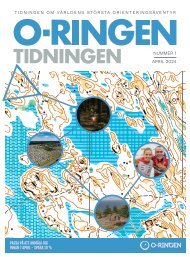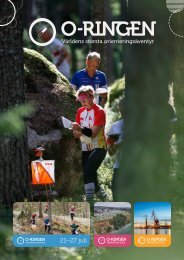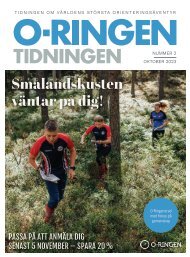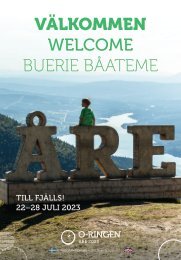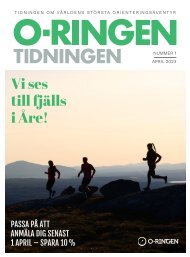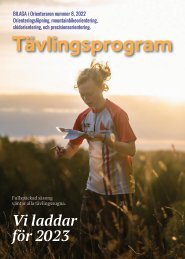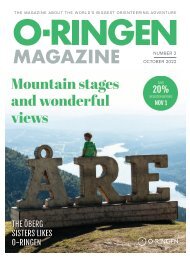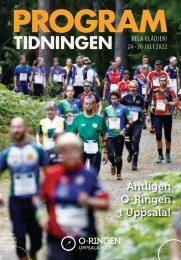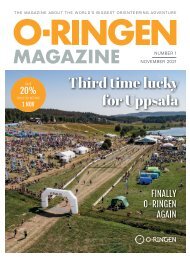O-Ringen Magazine Nr 2 - 2023.
The worlds biggest orienteering event. 21-27 july 2024.
The worlds biggest orienteering event. 21-27 july 2024.
You also want an ePaper? Increase the reach of your titles
YUMPU automatically turns print PDFs into web optimized ePapers that Google loves.
REGISTRATION GUIDE O-RINGEN SMÅLANSKUSTEN 2024 <br />
REGISTRATION GUIDE O-RINGEN SMÅLANSKUSTEN 2024 <br />
O-<strong>Ringen</strong>s biggest and most classic competition is<br />
to compete over five days.<br />
The winner for many of the classes is determined<br />
by an exciting chasing start on the final day of<br />
competition, available for Foot-O and Trail-O.<br />
MAIN CLASSES<br />
Our five-day main classes are most popular. You have an allocated,<br />
timed start. Our youngest competitors get an introduction to<br />
orienteering with the Inskolning class, where you can start when you<br />
want and everyone gets a prize, and the results only show who has<br />
taken part, with no times or positions. The competition is decided on<br />
the final day with a chasing start for everyone except Inskolning and<br />
DH10–DH12.<br />
New for O-<strong>Ringen</strong> 2024, DH75 and older have a free minute start,<br />
which means you choose a start minute when you get to the start.<br />
Class Middle Long Difficulty Class Middle Long<br />
Inskolning 1,5 1,5 Beginner Para-I 2,0 2,0<br />
D10 2,0 2,5 Very easy H10 2,0 2,5<br />
D11 2,5 3 Easy H11 2,5 3<br />
D12 2,5 3 Easy H12 2,5 3<br />
D13 3,0 4,4 Moderate H13 3,0 4,4<br />
D14 3,0 4,4 Moderate H14 3,0 4,4<br />
D15 3,5 5,5 Moderate H15 3,5 6<br />
D16 3,5 5,5 Moderate H16 3,5 6<br />
D18 3,5 5,5 Difficult H18 3,5 7,1<br />
D20 3,5 6 Difficult H20 3,5 7,7<br />
D21 3,5 7,7 Difficult H21 5,0 9,9<br />
D21 Lång 4,5 9,3 Difficult H21 Lång 5,5 11,5<br />
D35 4,0 6,6 Difficult H35 5,0 8,8<br />
D40 4,0 5,5 Difficult H40 4,8 8,2<br />
D45 4,0 4,9 Difficult H45 4,8 7,1<br />
D50 3,5 4,4 Difficult H50 4,5 6,6<br />
D55 3,5 4,4 Difficult H55 4,0 6,1<br />
D60 3,5 3,9 Difficult H60 4,0 5,5<br />
D65 3,0 3,8 Difficult H65 3,5 5<br />
D70 3,0 3,3 Difficult H70 3,5 4,4<br />
D75 3,0 3,1 Difficult H75 3,0 3,9<br />
D80 2,5 2,5 Difficult H80 2,5 3<br />
D85 2,5 2,5 Difficult H85 2,0 2,5<br />
D90 1,5 2 Difficult H90 1,5 2<br />
D95 1,5 1,5 Difficult H95 1,5 1,5<br />
PARA-I<br />
5-DAYS<br />
Para-I is for anyone with an intellectual disability. The difficulty<br />
level of the class is green (very easy).<br />
The Para-I class is available on all five days, and as a chasing<br />
start. It is open to anyone with an IQ of under 75, the equivalent<br />
to attending a special school or having LSS support in Sweden.<br />
You do not need a Parapsports licence to compete. The Para-I<br />
course is very easy and is around 2 km. All five stages are foot<br />
RECREATIONAL CLASSES<br />
Compete on easier courses in classes according to age and sex. Start<br />
when you want every day and no chasing start on the final day.<br />
Class Middle Long Difficulty Class Middle Long<br />
D21 Motion 3,7 5,5 Moderate H21 Motion 4 6,6<br />
D35 Motion 3,2 4,6 Moderate H35 Motion 3,8 6,3<br />
D40 Motion 3 4,4 Moderate H40 Motion 3,6 6,1<br />
D45 Motion 2,8 4,1 Moderate H45 Motion 3,5 4,9<br />
D50 Motion 2,7 3,8 Moderate H50 Motion 3,3 4,7<br />
D55 Motion 2,6 3,6 Moderate H55 Motion 3,2 4,6<br />
D60 Motion 2,5 3,4 Moderate H60 Motion 3 4,3<br />
D65 Motion 2,3 3,2 Moderate H65 Motion 2,9 4<br />
D70 Motion 2,2 2,9 Moderate H70 Motion 2,6 3,8<br />
D80 Motion 2 2,5 Moderate H80 Motion 2 2,5<br />
SHORT CLASSES<br />
Shorter than competition classes but with the same technical<br />
challenge. Classes have a free minute start, which means you<br />
choose a start minute when you get to the start. Chasing start for<br />
all classes on the final day. There are no DH75 or DH80 Short, we<br />
recommend DH75 or DH80 instead – see Main classes.<br />
Class Middle Long Difficulty Class Middle Long<br />
D12 Kort 2,0 2,5 Very easy H12 Kort 2,0 2,5<br />
D14 Kort 2,5 3,0 Easy H14 Kort 2,5 3,0<br />
D16 Kort 3,0 4,4 Moderate H16 Kort 3,0 4,4<br />
D17-20 Kort 3,0 4,5 Moderate H17-20 Kort 3,2 5,5<br />
D21 Kort 4,0 5,5 Difficult H21 Kort 4,5 7,6<br />
D35 Kort 3,6 4,5 Difficult H35 Kort 4,3 6,3<br />
D40 Kort 3,3 4,1 Difficult H40 Kort 4,2 5,7<br />
D45 Kort 3,3 3,9 Difficult H45 Kort 4,1 5<br />
D50 Kort 3,0 3,7 Difficult H50 Kort 3,8 4,8<br />
D55 Kort 3,0 3,5 Difficult H55 Kort 3,5 4,6<br />
D60 Kort 2,3 3,2 Difficult H60 Kort 3,3 4,0<br />
D65 Kort 2,2 3 Difficult H65 Kort 2,8 3,8<br />
D70 Kort 2,1 2,7 Difficult H70 Kort 2,6 3,3<br />
orienteering, which means that accessibility is not adapted to<br />
anyone using a wheelchair or other mobility aid. If you do use<br />
any mobility aids, we recommend our Trail-O classes.<br />
The Para-I class is open for all ages. There is a free start for all<br />
stages and timing using SportIdent. Competitors can be joined<br />
by a coach/adult/friend on the course.<br />
OPEN CLASSES<br />
There are twelve open orienteering classes, with different lengths<br />
and technical difficulty levels, that you can run every day. Start<br />
when you like.<br />
Class Middle Difficulty<br />
Lätt 2,5 2,0 Easy<br />
Lätt 3,5 2,8 Easy<br />
Lätt 5,0 4,0 Easy<br />
Lätt 10,0 6,0 Easy<br />
Medelsvår 2,5 2,0 Moderate<br />
Medelsvår 3,3 2,5 Moderate<br />
Medelsvår 4,0 3,0 Moderate<br />
TRAIL-O CLASSES<br />
In the Trail-O competition map knowledge is<br />
in focus. Each control has up to five alternate<br />
control markers. You must remotely determine<br />
which control marker is correctly placed<br />
according to the control ring on the map and<br />
the control description. You compete in a class<br />
determined by its difficulty level, rather than<br />
age and gender. The competition takes place in<br />
easily passable terrain.<br />
68 O-RINGEN MAGAZINE NR 2 • 2023 O-RINGEN MAGAZINE NR 2 • 2023 69<br />
MTBO<br />
Class Middle Difficulty<br />
Medelsvår 5,0 4,0 Moderate<br />
Medelsvår 6,0 4,5 Moderate<br />
Svår 2,5 2,0 Difficult<br />
Svår 3,5 2,8 Difficult<br />
Svår 5,0 4,4 Difficult<br />
Svår 7,5 6,0 Difficult<br />
There are five MTBO stages at O-<strong>Ringen</strong> 2024. Start times are<br />
pre-allocated and the competition finishes with a chasing start on<br />
the final day. MTBO is high-speed and is all about making quick<br />
route choice decisions. The maps are like those used in Foot-O. The<br />
biggest difference is how paths and tracks are marked. They show<br />
how easy they are to ride on. Put simply, the longer the dashes on<br />
the lines, the easier they are to ride.<br />
OPEN MTBO CLASSES<br />
Class/Course Sprint Middle Long Cykelnivå<br />
Lätt mellan 3,0 6,0 10,0 Moderate<br />
Lätt lång 3,5 7,0 15,0 Svår<br />
Svår mellan 4,3 6,0 10,0 Svår<br />
Level<br />
Beginner<br />
Very easy<br />
Easy<br />
Moderate<br />
Description<br />
MTBO CLASSES<br />
Class Sprint Middle Long<br />
D12 2,5 3,0 5,5<br />
D14 3,0 5,0 8,5<br />
D16 4,0 5,5 10,0<br />
D20 4,5 7,0 14,5<br />
D21 5,5 8,5 20,0<br />
D35 4,5 7,0 13,0<br />
D40 4,5 7,0 13,0<br />
D45 4,5 7,0 13,0<br />
D50 4,0 6,0 11,0<br />
D55 3,5 6,0 11,0<br />
D60 3,5 5,0 9,0<br />
D65 3,5 5,0 9,0<br />
D70 3,0 4,0 7,5<br />
D75 3,0 4,0 7,5<br />
D80 2,5 4,0 7,5<br />
Class<br />
Pre-Elit<br />
Pre-A<br />
Pre-B<br />
Pre-C<br />
Class Sprint Middle Long<br />
H12 2,5 3,0 5,5<br />
H14 3,5 5,5 8,5<br />
H16 4,5 7,0 13,0<br />
H20 5,5 9,0 21,0<br />
H21 6,0 11,0 25,0<br />
H35 5,5 8,0 17,5<br />
H40 5,5 8,0 17,5<br />
H45 5,5 8,0 17,5<br />
H50 5,0 7,5 15,0<br />
H55 5,0 7,5 15,0<br />
H60 5,0 6,0 13,0<br />
H65 4,0 6,0 13,0<br />
H70 4,0 5,0 11,0<br />
D75 3,5 5,0 11,0<br />
D80 3,5 5,0 11,0<br />
LEVELS OF DIFFICULTY - MAIN-, SHORT-, RECREATIONAL- AND OPEN CLASSES<br />
Moderate<br />
Moderate<br />
Difficult<br />
Difficult<br />
The course is in terrain with clear and connected features such as roads, larger paths, buildings and open land. The controls on a<br />
green course must always be placed on handrails and must provide reassurance that the competitor is following the correct route.<br />
Control features may be path bends, path junctions, telegraph posts, buildings or other clear features or objects.<br />
The terrain is the same as for green courses, i.e. clear and connected features, e.g. roads, larger paths, open land and buildings. The<br />
controls on a white course must mark only the end of one leg and the start of the next. The control features must therefore be easily<br />
identified and distinct. As well as green course features, controls on white courses may also be on e.g. boulders, crags, fences and<br />
similar features.<br />
Yellow courses can be in more difficult terrain but runnability and visibility must still be good. The terrain must have a connected<br />
network of roads, paths, fences, waterways, open areas etc. Control points may be on more difficult features, for example on the top<br />
of a very distinct hill, but must always have a clear attack point. There must be a clear catching feature behind controls.<br />
Orange and red courses must use runnable terrain, with gentler hills and forest, preferably with areas of cultivated land. Terrain<br />
details must be clear. Compared to green, white and yellow courses, more difficult control features may be used, for example larger<br />
re-entrants, distinct ridges, hills and crags. There must be a clear feature a maximum of 200 m before the control and a clear catching<br />
feature behind it.<br />
Same as for orange courses but you can encounter all types of terrain.<br />
All types of terrain may be used. Very physically tough terrain should be avoided. All types of control feature may be used. Compared<br />
to orange and red courses, purple courses place higher demands on, planning skills, choosing quick routes ahead of safe routes and<br />
finding controls without clear catching features behind them.<br />
On blue and black courses, the difficulty should always suit skilled orienteers, even if anyone can compete. The increased difficulty<br />
level compared to other courses is because more of the orienteering uses contour features, detailed terrain and smaller features.<br />
Same as for blue courses but you can encounter all types of terrain.




